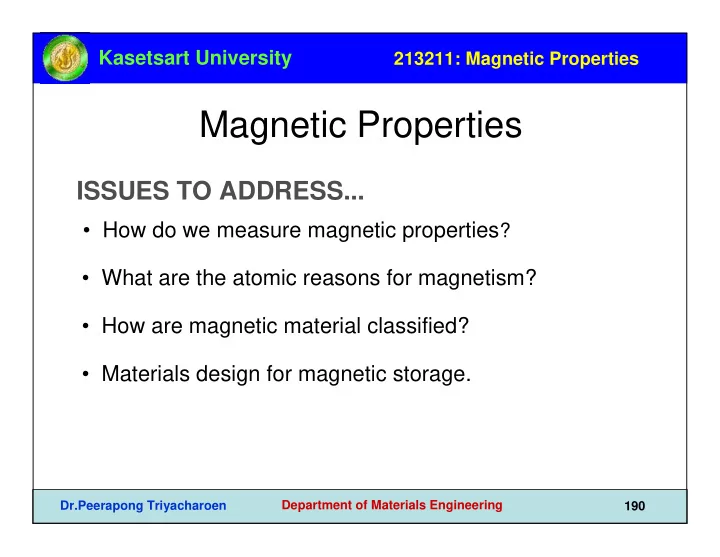

Kasetsart University 213211: Magnetic Properties Magnetic Properties ISSUES TO ADDRESS... • How do we measure magnetic properties ? • What are the atomic reasons for magnetism? • How are magnetic material classified? • Materials design for magnetic storage. Department of Materials Engineering Dr.Peerapong Triyacharoen 190
Kasetsart University 213211: Magnetic Properties Applied Magnetic Field • Created by current through a coil: Applied N turns total magnetic field H L = length of each turn current I • Relation for the applied magnetic field, H: H = NI current L applied magnetic field units = (ampere-turns/m) Department of Materials Engineering Dr.Peerapong Triyacharoen 191
Kasetsart University 213211: Magnetic Properties Response To A Magnetic Field • Magnetic induction results in the material B = Magnetic Induction (tesla) inside the material current I • Magnetic susceptibility, χ (dimensionless) B χ > 0 χ measures the vacuum χ = 0 material response χ < 0 relative to a vacuum. H Department of Materials Engineering Dr.Peerapong Triyacharoen 192
Kasetsart University 213211: Magnetic Properties Magnetic Susceptibility • Measures the response of electrons to a magnetic field. • Electrons produce magnetic moments: magnetic moments electron electron spin nucleus • Net magnetic moment: --sum of moments from all electrons. • Three types of response... Department of Materials Engineering Dr.Peerapong Triyacharoen 193
Kasetsart University 213211: Magnetic Properties 3 Types Of Magnetism B = (1 + χ ) µ o H permeability of a vacuum: (1.26 x 10 -6 Henries/m) Magnetic induction (B--tesla) ferromagnetic e.g., Fe3O4, NiFe2O4 (3) ferrimagnetic e.g., ferrite( α ), Co, Ni, Gd ( χ as large as 106 !) (2) paramanetic e.g., Al, Cr, Mo, Na, Ti, Zr vacuum ( χ = 0) diamagnetic ( χ ~ -10-5) (1) e.g., Al2O3, Cu, Au, Si, Ag, Zn Strength of applied magnetic field (H) (ampere-turns/m) Department of Materials Engineering Dr.Peerapong Triyacharoen 194
Kasetsart University 213211: Magnetic Properties Magnetic Moments For 3 Types No Applied Applied Magnetic Field (H = 0) Magnetic Field (H) opposing none (1) diamagnetic random aligned (2) paramagnetic aligned aligned (3) ferromagnetic ferrimagnetic Department of Materials Engineering Dr.Peerapong Triyacharoen 195
Kasetsart University 213211: Magnetic Properties Ferro- & Ferri-magnetic Materials • As the applied field (H) increases... --the magnetic moment aligns with H. Bsat H induction (B) H • “Domains” with Magnetic H aligned magnetic moment grow at H expense of poorly aligned ones! H 0 Applied Magnetic Field (H) H = 0 Department of Materials Engineering Dr.Peerapong Triyacharoen 196
Kasetsart University 213211: Magnetic Properties Permanent Magnets • Process: B 2. apply H, cause 3. remove H, alignment stays! alignment -> permanent magnet! Applied Magnetic Field (H) 4. Coercivity, Hc: 1. initial (unmagnetized state) Negative H needed to demagnitize! B • Hard vs Soft Magnets large coercivity Hard Hard --good for perm magnets --add particles/voids to Soft Applied Magnetic make domain walls Field (H) hard to move (e.g., tungsten steel: small coercivity--good for elec. motors H c = 5900 amp-turn/m) (e.g., commercial iron 99.95 Fe) Department of Materials Engineering Dr.Peerapong Triyacharoen 197
Kasetsart University 213211: Magnetic Properties Magnetic Storage • Information is stored by magnetizing material. • Head can... recording medium --apply magnetic field H & align domains (i.e., magnetize the medium). --detect a change in the Simulation of hard drive magnetization of the courtesy Martin Chen. Reprinted with permission recording head medium. from International Business Machines Corporation. • Two media types: --Particulate: needle-shaped --Thin film: CoPtCr or CoCrTa g-Fe 2 O 3 . +/- mag. moment alloy. Domains are ~ 10-30nm! along axis. (tape, floppy) (hard drive) ~2.5 µ m ~60nm Department of Materials Engineering Dr.Peerapong Triyacharoen 198
Kasetsart University 213211: Magnetic Properties Summary • A magnetic field can be produced by: --putting a current through a coil. • Magnetic induction: --occurs when a material is subjected to a magnetic field. --is a change in magnetic moment from electrons. • Types of material response to a field are: --ferri- or ferro-magnetic (large magnetic induction) --paramagnetic (poor magnetic induction) --diamagnetic (opposing magnetic moment) • Hard magnets: large coercivity. • Soft magnets: small coercivity. • Magnetic storage media: --particulate g-Fe 2 O 3 in polymeric film (tape or floppy) --thin film CoPtCr or CoCrTa on glass disk (hard drive) Department of Materials Engineering Dr.Peerapong Triyacharoen 199
Recommend
More recommend